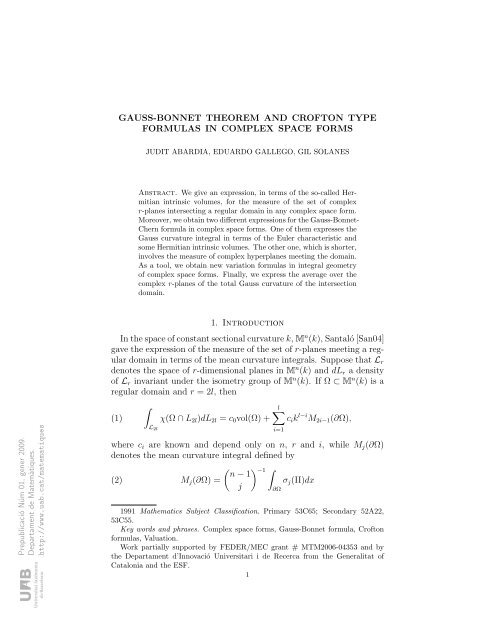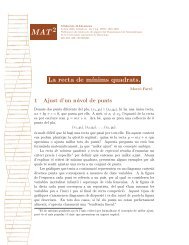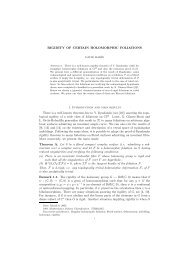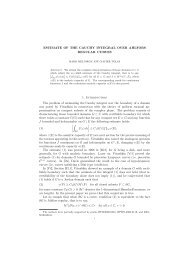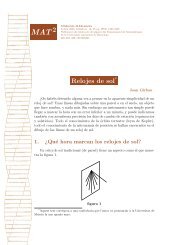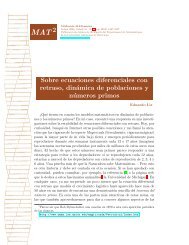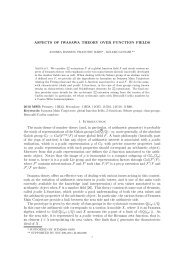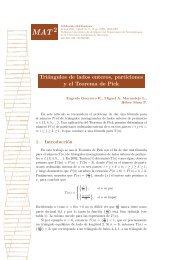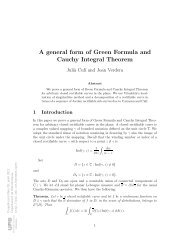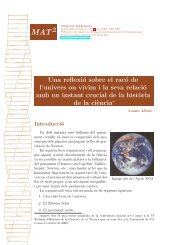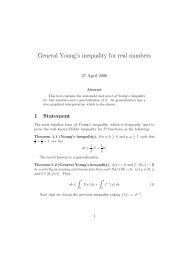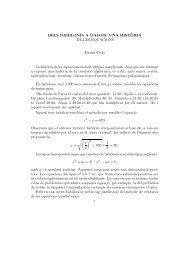GAUSS-BONNET THEOREM AND CROFTON TYPE FORMULAS IN ...
GAUSS-BONNET THEOREM AND CROFTON TYPE FORMULAS IN ...
GAUSS-BONNET THEOREM AND CROFTON TYPE FORMULAS IN ...
Create successful ePaper yourself
Turn your PDF publications into a flip-book with our unique Google optimized e-Paper software.
<strong>GAUSS</strong>-<strong>BONNET</strong> <strong>THEOREM</strong> <strong>AND</strong> <strong>CROFTON</strong> <strong>TYPE</strong><br />
<strong>FORMULAS</strong> <strong>IN</strong> COMPLEX SPACE FORMS<br />
JUDIT ABARDIA, EDUARDO GALLEGO, GIL SOLANES<br />
Abstract. We give an expression, in terms of the so-called Hermitian<br />
intrinsic volumes, for the measure of the set of complex<br />
r-planes intersecting a regular domain in any complex space form.<br />
Moreover, we obtain two different expressions for the Gauss-Bonnet-<br />
Chern formula in complex space forms. One of them expresses the<br />
Gauss curvature integral in terms of the Euler characteristic and<br />
some Hermitian intrinsic volumes. The other one, which is shorter,<br />
involves the measure of complex hyperplanes meeting the domain.<br />
As a tool, we obtain new variation formulas in integral geometry<br />
of complex space forms. Finally, we express the average over the<br />
complex r-planes of the total Gauss curvature of the intersection<br />
domain.<br />
Prepublicació Núm 01, gener 2009.<br />
Departament de Matemàtiques.<br />
http://www.uab.cat/matematiques<br />
1. Introduction<br />
In the space of constant sectional curvature k, M n (k), Santaló [San04]<br />
gave the expression of the measure of the set of r-planes meeting a regular<br />
domain in terms of the mean curvature integrals. Suppose that L r<br />
denotes the space of r-dimensional planes in M n (k) and dL r a density<br />
of L r invariant under the isometry group of M n (k). If Ω ⊂ M n (k) is a<br />
regular domain and r = 2l, then<br />
(1)<br />
∫<br />
L 2l<br />
χ(Ω ∩ L 2l )dL 2l = c 0 vol(Ω) +<br />
l∑<br />
c i k l−i M 2i−1 (∂Ω),<br />
where c i are known and depend only on n, r and i, while M j (∂Ω)<br />
denotes the mean curvature integral defined by<br />
( ) −1 ∫ n − 1<br />
(2) M j (∂Ω) =<br />
σ j (II)dx<br />
j<br />
∂Ω<br />
1991 Mathematics Subject Classification. Primary 53C65; Secondary 52A22,<br />
53C55.<br />
Key words and phrases. Complex space forms, Gauss-Bonnet formula, Crofton<br />
formulas, Valuation.<br />
Work partially supported by FEDER/MEC grant # MTM2006-04353 and by<br />
the Departament d’Innovació Universitari i de Recerca from the Generalitat of<br />
Catalonia and the ESF.<br />
1<br />
i=1
2 JUDIT ABARDIA, EDUARDO GALLEGO, GIL SOLANES<br />
where σ j (II) is the j-th symmetric elementary function of the eigenvalues<br />
of the second fundamental form. An analogous formula holds in<br />
the case of odd-dimensional planes.<br />
In the proof of formula (1), Santaló used the Gauss-Bonnet-Chern<br />
theorem in M n (k), that for n even states<br />
(3)<br />
M n−1 (∂Ω)= O n<br />
2 χ(Ω)−kc n−3M n−3 (∂Ω)−...−k n−2<br />
2 c1 M 1 (∂Ω)−k n 2 vol(Ω),<br />
and the reproductive property of the mean curvature integrals in M n (k),<br />
∫<br />
(4)<br />
(∂Ω ∩ L r )dL r = cM i (∂Ω),<br />
M (r)<br />
i<br />
L r<br />
where M (r)<br />
i (∂Ω∩L r ) denotes the i-th mean curvature integral of ∂Ω∩L r<br />
as a hypersurface in L r and c is known and depends only on n, r and<br />
i.<br />
In this paper we generalize formula (1) and (3) to the space of constant<br />
holomorphic curvature 4ɛ, CK n (ɛ). The role of L r in (1) will be<br />
played by L C r , the space of complex r-planes (totally geodesic complex<br />
submanifolds). For simplicity, we shall restrict to compact domains<br />
Ω ⊂ CK n (ɛ) with smooth boundary, and call them regular domains.<br />
The method used by Santaló cannot be applied in this situation.<br />
Mean curvature integrals are defined in a complex space form as in (2),<br />
but in the standard Hermitian space C n , it was not certain whether the<br />
reproductive property remains true for the mean curvature integrals<br />
when we integrate it over L C r . Moreover, in the complex projective<br />
space and in the complex hyperbolic space, an explicit Gauss-Bonnet<br />
formula is not known. Instead, we use variational arguments, as well<br />
as some facts about the theory of valuations, which we briefly describe<br />
next.<br />
Definition 1.1. Let K(V ) denote the family of non-empty compact<br />
convex subsets of a finite dimensional real vector space V of dimension<br />
n. A scalar valued functional φ : K(V ) → C is called a valuation if<br />
whenever A, B, A ∪ B ∈ K(V ).<br />
φ(A ∪ B) = φ(A) + φ(B) − φ(A ∩ B)<br />
The space of invariant valuations under the full group of isometries of<br />
R n was studied by Hadwiger [Had57], who proved that the dimension<br />
of this space is n + 1. Mean curvature integrals, volume and Euler<br />
characteristic form a basis of this space.<br />
On the standard Hermitian space C n with its isometry group IU(n) =<br />
C n ⋊ U(n), Alesker [Ale03] proved that there are more linearly independent<br />
valuations than on R n , the dimension of this space is ( )<br />
n+2<br />
2 .<br />
Both the Euler characteristic, and the measure of complex planes intersecting<br />
the domain belong to this space.
<strong>GAUSS</strong>-<strong>BONNET</strong> <strong>THEOREM</strong> <strong>IN</strong> COMPLEX SPACE FORMS 3<br />
Bernig and Fu [BF08], consider several valuation bases on C n . Here<br />
we will use the basis whose elements {µ k,q } {k,q} are called Hermitian<br />
intrinsic volumes. These valuations where first introduced by Park<br />
in complex space forms (cf. [Par02]). In section 2 we recall their<br />
definition.<br />
The main results of this paper can be stated as follows.<br />
Theorem 1.2. Let Ω be a regular domain in CK n (ɛ). Then, for r =<br />
1, ..., n − 1<br />
∫<br />
( ) −1 n − 1<br />
χ(Ω ∩ L r )dL r = vol(G C n−1,r) (ɛ r (r + 1)vol(Ω)+<br />
r<br />
(5)<br />
L C r<br />
+<br />
∑n−1<br />
k=n−r<br />
+<br />
ɛ k−(n−r) ω 2n−2k<br />
( n<br />
k) −1<br />
· ((k + r − n + 1)µ 2k,k +<br />
∑k−1<br />
q=max{0,2k−n}<br />
( )<br />
1 2k − 2q<br />
µ<br />
4 k−q 2k,q ))<br />
k − q<br />
where dL r denotes an invariant measure in the space of complex r-<br />
planes L C r . Moreover,<br />
(6)<br />
O 2n−1 χ(Ω) = 2n(n + 1)ɛ n vol(Ω) +<br />
⎛<br />
⎞<br />
∑n−1<br />
ɛ c O 2n−2c−1<br />
∑c−1<br />
( )<br />
+ ) ⎝<br />
1 2c − 2q<br />
µ<br />
4 c−q 2c,q +(c + 1)µ 2c,c<br />
⎠<br />
c − q<br />
c=0<br />
( n−1<br />
c<br />
q=max{0,2c−n}<br />
where ω i denotes the volume of the euclidean unit ball and O i the volume<br />
of the euclidean unit sphere.<br />
Formula (5) is a generalization of (1) in the sense that the measure<br />
of the complex r-planes meeting a regular domain is expressed as a<br />
linear combination of the volume and some other valuations related to<br />
mean curvature integrals. This answers a question posed by Naveira<br />
in [Nav05]. In case r = 1, formula (5) was already proved by different<br />
methods in [Aba09]. For 2r ≥ n, and ɛ = 0, formula (5) was proved in<br />
[BF08].<br />
Formula (6) generalizes to complex space forms the Gauss-Bonnet<br />
theorem (3). In complex dimensions n = 2, 3, formula (6) was obtained<br />
in [Par02].<br />
Combining expressions (5) and (6) we obtain<br />
∫<br />
M 2n−1 (∂Ω) = O 2n−1 χ(Ω) − 2nɛ χ(Ω ∩ L n−1 )dL n−1 −<br />
k=1<br />
L C n−1<br />
∑n−1<br />
( ) −1 n − 1<br />
− ɛ k O 2n−2k−1 µ 2k,k − 2nɛ n vol(Ω).<br />
k<br />
This expression is similar to the following one for real space forms.
4 JUDIT ABARDIA, EDUARDO GALLEGO, GIL SOLANES<br />
Theorem ([Sol06]). Let S be a hypersurface bounding a compact domain<br />
Q in a real space form with sectional curvature k and dimension<br />
n. Then<br />
∫<br />
2(n − 1)<br />
M n−1 (S) = O n−1 χ(Q) − k χ(Q ∩ L n−2 )dL n−2 .<br />
O n−2 L n−2<br />
The main idea for the proof of Theorem 1.2 is to take variation along<br />
a vector field in CK n (ɛ), in both sides of equalities (5) and (6), and to<br />
compare them.<br />
In order to obtain a first expression of the variation of ∫ χ(∂Ω ∩<br />
L C r<br />
L r )dL r along a vector field in CK n (ɛ), we proceed as in [Sol06] (see<br />
Section 3.1). In C n , the variation of the Hermitian intrinsic volumes<br />
was obtained by Bernig and Fu [BF08]. Here we use the same method<br />
to find the generalization for ɛ ≠ 0 (see Section 3.2).<br />
Using formula (5), we prove in Section 6 that the total Gauss curvature<br />
does not satisfy the reproductive property and we get in C n the<br />
following expression:<br />
∫<br />
( ) −1 ( ) n − 1 n<br />
M 2r−1 (∂Ω ∩ L r )dL r = 2rω2rvol(G 2 C n−1,r)<br />
−1·<br />
r r<br />
L C r<br />
(7)<br />
⎛<br />
· ⎝<br />
∑n−r<br />
q=max{0,n−2r}<br />
( )<br />
1 2n − 2r − 2q<br />
4 n−r−q n − r − q<br />
⎞<br />
µ 2n−2r,q<br />
⎠ .<br />
In [Aba09], it is proved that the reproductive property (4) is not<br />
satisfied by the mean curvature integral either.<br />
Acknowledgments<br />
We wish to thank Andreas Bernig for illuminating discussions during<br />
the preparation of this work.<br />
2. Hermitian intrinsic volumes on CK n (ɛ)<br />
Let CK n (ɛ) be a (simply connected) complex space form with constant<br />
holomorphic curvature 4ɛ. We denote by T ′ CK n (ɛ) the unit tangent<br />
bundle of CK n (ɛ).<br />
Definition 2.1. Let Ω be a regular domain in CK n (ɛ). The unit (inner)<br />
normal bundle of ∂Ω is defined as<br />
N(Ω) ={(p, v) ∈ T ′ CK n (ɛ) : p ∈ ∂Ω, v inner normal to T ′ p∂Ω}.<br />
Given a 4n − 1 form ω in T ′ CK n (ɛ) we may consider, for every<br />
regular domain Ω the integral over N(Ω) of the form ω. The resulting<br />
functional is called a smooth valuation.<br />
Let z ∈ CK n (ɛ), e 1 ∈ T ′ CK n (ɛ) and let {z; e 1 , ..., e n } be a moving<br />
frame defined on an open subset U ⊂ T ′ CK n (ɛ). We denote by
<strong>GAUSS</strong>-<strong>BONNET</strong> <strong>THEOREM</strong> <strong>IN</strong> COMPLEX SPACE FORMS 5<br />
{ω 1 , ω 2 , ..., ω n } the 1-forms on T ′ CK n (ɛ) defined as the dual basis of<br />
{e 1 , ..., e n }, and by {ω ij } the connection forms of CK n (ɛ). That is, if<br />
( , ) denotes the Hermitian product on CK n (ɛ) and ∇ the Levi-Civita<br />
connection, then<br />
ω j = (dz, e j ) and ω jk = (∇e j , e k ) where j, k ∈ {1, ..., n}.<br />
Thus, these forms are C-valued. We denote<br />
(8)<br />
ω j = α j + iβ j ,<br />
ω jk = α jk + iβ jk .<br />
Remark 2.2. Forms α 1 , β 1 and β 11 are global forms in T ′ CK n (ɛ). We<br />
denote by α, β, γ the forms α 1 , β 1 , β 11 , respectively. Note that α<br />
coincides with the contact form of the unit tangent bundle.<br />
Lemma 2.3. Let Ω ⊂ CK n (ɛ) be a regular domain. Forms α and dα<br />
vanish at N(Ω) ⊂ T ′ CK n (ɛ).<br />
Proof. Let V ∈ T (p,v) N(Ω). Then, α(V ) (p,v) = 〈dπ(V ), v〉 = 0 where<br />
π : T ′ CK n (ɛ) → CK n (ɛ) is the canonical projection.<br />
To prove that dα vanishes at the unit normal bundle, we consider<br />
the inclusion of the unit normal bundle to the unit tangent bundle<br />
i : N(Ω) → T ′ (Ω) and we use that exterior differential commutes with<br />
the inclusion map to obtain<br />
(9)<br />
dα| N(Ω) = (i ∗ ◦ d)(α) = (d ◦ i ∗ )(α) = d(i ∗ α) = d(0) = 0.<br />
Consider the following 2-forms in T ′ CK n (ɛ)<br />
n∑<br />
θ 0 = −Im((∇e 1 , ∇e 1 )) = −Im( ω 1i ⊗ ω 1i )<br />
i=1<br />
θ 1 = −Im((dz, ∇e 1 ) − (∇e 1 , dz))<br />
n∑<br />
n∑<br />
= −Im( ω i ⊗ ω 1i − ω 1i ⊗ ω i )<br />
i=1<br />
i=1<br />
θ 2 = −Im((dz, dz)) = −Im(<br />
n∑<br />
ω i ⊗ ω i )<br />
i=1<br />
θ s = Re((dz, ∇e 1 ) − (∇e 1 , dz))<br />
n∑<br />
n∑<br />
= Re( ω i ⊗ ω 1i − ω 1i ⊗ ω i ).<br />
i=1<br />
This forms coincide with the invariant 2-forms, θ 0 , θ 1 , θ 2 and θ s<br />
defined in T ′ C n by Bernig and Fu [BF08, p.14]. Note that, θ s is the<br />
symplectic form of T CK n (ɛ).<br />
Remark 2.4. Park [Par02] defined invariant 2-forms in T ′ CK n (ɛ) similar<br />
to the ones in (9).<br />
i=1<br />
□
6 JUDIT ABARDIA, EDUARDO GALLEGO, GIL SOLANES<br />
The forms β k,q and γ k,q defined in T ′ C n in [BF08], can be extended<br />
to T ′ CK n (ɛ) from (9).<br />
Definition 2.5. For positive integers k, q ∈ N with max{0, k − n} ≤<br />
q ≤ k 2 < n, it is defined in Ω2n−1 (T ′ CK n (ɛ))<br />
where<br />
β k,q := c n,k,q β ∧ θ n−k+q<br />
0 ∧ θ k−2q−1<br />
1 ∧ θ q 2, k ≠ 2q<br />
γ k,q := c n,k,q<br />
2 γ ∧ θn−k+q−1 0 ∧ θ k−2q<br />
1 ∧ θ2, q n ≠ k − q<br />
1<br />
c n,k,q :=<br />
q!(n − k + q)!(k − 2q)!ω 2n−k<br />
and ω 2n−k denotes the volume of the (2n − k)-dimensional euclidean<br />
ball.<br />
Given a regular domain Ω ⊂ CK n (ɛ), we define (for max{0, k − n} ≤<br />
q ≤ k < n) 2<br />
∫<br />
∫<br />
Bk,q(Ω) Ω := β k,q (k ≠ 2q), Γ Ω k,q(Ω) :=<br />
(n ≠ k−q).<br />
N(Ω)<br />
γ k,q<br />
N(Ω)<br />
In C n , it is satisfied B Ω k,q (Ω) = ΓΩ k,q (Ω) since dβ k,q = dγ k,q . Next we<br />
recall the exterior derivative of θ 0 , θ 1 and θ 2 , which can be found in<br />
[BF08] when ɛ = 0, or in [Par02] for general ɛ.<br />
Lemma 2.6 ([Par02]). In T ′ CK n (ɛ) it is satisfied<br />
dα = −θ s , dθ 0 = −ɛ(α ∧ θ 1 + β ∧ θ s ),<br />
dβ = θ 1 , dθ 1 = 0,<br />
dγ = 2θ 0 − 2ɛθ 2 − 2ɛα ∧ β, dθ 2 = 0.<br />
Next, we give the relation among {B Ω k,q (Ω)} and {ΓΩ k,q (Ω)} in CKn (ɛ)<br />
which generalizes the relation in C n .<br />
Proposition 2.7. In CK n (ɛ), for any positive integers k, q such that<br />
max{0, k − n} < q < k/2 < n it is satisfied<br />
c n,k,q<br />
Γ Ω k,q(Ω) = Bk,q(Ω) Ω − ɛ B<br />
c<br />
k+2,q+1(Ω).<br />
Ω<br />
n,k+2,q+1<br />
Proof. We denote by I the ideal generated by α, dα and the exact forms<br />
in N(Ω). If λ, ρ are (2n − 1)-forms in N(Ω) equal modulo I, then by<br />
Lemma 2.3<br />
∫ ∫<br />
λ = ρ.<br />
Thus, it is enough to prove<br />
N(Ω)<br />
c n,k,q<br />
N(Ω)<br />
(10) γ k,q ≡ β k,q − ɛ β k+2,q+1 mod I.<br />
c n,k+2,q+1
<strong>GAUSS</strong>-<strong>BONNET</strong> <strong>THEOREM</strong> <strong>IN</strong> COMPLEX SPACE FORMS 7<br />
Consider the form η = (θ s − β ∧ γ) ∧ θ n−k+q−1<br />
0 θ k−2q−1<br />
1 θ q 2. As dη is<br />
exact, we have dη ≡ 0 mod I. On the other hand, by Lemma 2.6 it<br />
follows that modulo I<br />
dη ≡ −γθ n−k+q−1<br />
0 θ k−2q<br />
1 θ q 2+2βθ n−k+q<br />
0 θ k−2q−1<br />
1 θ q 2−2ɛβθ n−k+q−1<br />
0 θ k−2q−1<br />
1 θ q+1<br />
2 .<br />
Using the definition of γ k,q and β k,q we obtain the relation in (10).<br />
Remark 2.8. In complex dimensions n = 2, 3, the previous relations<br />
were found in [Par02].<br />
In view of the previous equalities, we define (for max{0, k − n} ≤<br />
q ≤ k < n) 2<br />
{ B<br />
Ω<br />
(11) µ k,q (Ω) := k,q (Ω) if k ≠ 2q<br />
Γ Ω 2q,q(Ω) if k = 2q.<br />
Remark 2.9. In [BF08], it is proved that valuations {µ k,q , vol} where<br />
k ∈ {0, ..., n − 1} and q ∈ {max{0, k − n}, ..., ⌊k/2⌋} form a basis of<br />
invariant continuous valuations on C n .<br />
3. Variation formulas<br />
3.1. Variation of Hermitian intrinsic volumes. In order to study<br />
the variation on CK n (ɛ) of the Hermitian intrinsic volumes, we follow<br />
the method used by Bernig and Fu [BF08] in Corollary 2.6. First, we<br />
recall the definition of the Rumin operator, introduced in [Rum94], and<br />
the definition of the Reeb vector field in a contact manifold.<br />
Definition 3.1. Given µ ∈ Ω 2n−1 (T ′ CK n (ɛ)), let α be the contact form<br />
of T ′ CK n (ɛ), and let α ∧ ξ ∈ Ω 2n−1 (T ′ CK n (ɛ)) be the unique form such<br />
that d(µ + α ∧ ξ) is multiple of α (cf. [Rum94]). Then the Rumin<br />
operator D is defined as<br />
Dµ := d(µ + α ∧ ξ).<br />
Definition 3.2. Let M be a contact manifold and let α be the contact<br />
form. The Reeb vector field T is the unique vector field over M such<br />
that<br />
{<br />
iT α = 1,<br />
(12)<br />
L T α = 0.<br />
If the contact manifold is the unit tangent bundle of a Riemannian<br />
manifold, then the Reeb vector field is the geodesic flow (cf. [Bla76, p.<br />
17]).<br />
Lemma 3.3. In T ′ CK n (ɛ), it is satisfied<br />
i T α = 1, i T θ 1 = γ,<br />
i T θ 2 = β, i T β = i T γ = i T θ 0 = 0.<br />
□
8 JUDIT ABARDIA, EDUARDO GALLEGO, GIL SOLANES<br />
Proof. The first equality comes directly from the definition (cf. (12)).<br />
As T is the geodesic flow, we have α i (T ) = β i (T ) = 0 and α 1i = β 1i = 0,<br />
i ∈ {2, ..., n}. By Definition in (9), we obtain the result.<br />
□<br />
Given a smooth valuation µ, and a vector field X with flow ϕ t , we<br />
are interested in computing<br />
δ X µ(Ω) := d dt∣ µ(ϕ t (Ω)).<br />
t=0<br />
This can be done by means of the following result stated in [BF08].<br />
Lemma 3.4 (Lemma 2.5 [BF08]). Suppose Ω ⊂ R n is a regular domain,<br />
N is the inner normal field to ∂Ω, X is a smooth vector field on<br />
C n and µ is a smooth valuation given by a (2n − 1)-form ρ. Then<br />
∫<br />
δ X µ(Ω) = 〈X, N〉 i T (Dρ)<br />
N(Ω)<br />
where T is the Reeb vector field on T ′ R n and Dρ is the Rumin operator<br />
of ρ.<br />
Although this result is stated and proved in C n , the given proof is<br />
also valid in an arbitrary Riemannian manifold.<br />
From Lemma 2.6, we obtain the exterior differential of the forms β k,q<br />
and γ k,q .<br />
Lemma 3.5. In CK n (ɛ)<br />
dβ k,q = c n,k,q (θ n−k+q<br />
0 ∧θ k−2q<br />
1 ∧θ q 2−ɛ(n−k+q)α∧β∧θ n−k+q−1<br />
0 ∧θ k−2q<br />
1 ∧θ q 2)<br />
and<br />
dγ k,q =c n,k,q (θ n−k+q<br />
0 ∧ θ k−2q<br />
1 ∧ θ q 2 − ɛθ n−k+q−1<br />
0 ∧ θ k−2q<br />
1 ∧ θ q+1<br />
2<br />
− ɛα ∧ β ∧ θ n−k+q−1<br />
0 ∧ θ k−2q<br />
1 ∧ θ q 2<br />
(n − k + q − 1)<br />
− ɛ α ∧ γ ∧ θ n−k+q−2<br />
0 ∧ θ k−2q+1<br />
1 ∧ θ q 2<br />
2<br />
(n − k + q − 1)<br />
− ɛ β ∧ γ ∧ θ s ∧ θ n−k+q−2<br />
0 ∧ θ k−2q<br />
1 ∧ θ q<br />
2<br />
2).<br />
Notation 3.6. Let Ω be a regular domain in CK n (ɛ) and let N be a<br />
normal field to ∂Ω. Let X be a smooth vector field on CK n (ɛ). We<br />
denote<br />
∫<br />
∫<br />
˜B k,q := ˜B k,q (Ω) = 〈X, N〉β k,q , ˜Γk,q := ˜Γ k,q (Ω) = 〈X, N〉γ k,q .<br />
∂Ω<br />
The variation of the valuations {µ k,q } on C n is given in [BF08, Proposition<br />
4.6]. The next proposition gives this variation in the previous<br />
notation.<br />
∂Ω
<strong>GAUSS</strong>-<strong>BONNET</strong> <strong>THEOREM</strong> <strong>IN</strong> COMPLEX SPACE FORMS 9<br />
Proposition 3.7 (Proposition 4.6 [BF08]).<br />
δ X µ k,q = 2c n,k,q (c −1<br />
n,k−1,q (k − 2q)2˜Γk−1,q − c −1<br />
n,k−1,q−1 (n + q − k)q˜Γ k−1,q−1<br />
+c −1<br />
n,k−1,q−1 (n + q − k + 1 2 )q ˜B k−1,q−1 −c −1<br />
n,k−1,q (k − 2q)(k − 2q − 1)˜B k−1,q ).<br />
We extend this result to CK n (ɛ) as follows.<br />
Proposition 3.8. Let X ∈ X(CK n (ɛ)) and let Ω ⊂ CK n (ɛ) be a regular<br />
domain. Then<br />
δ X B Ω k,q (Ω)= 2c n,k,q(c −1<br />
n,k−1,q (k − 2q)2˜Γk−1,q −c −1<br />
n,k−1,q−1 (n + q − k)q˜Γ k−1,q−1<br />
+ c −1<br />
n,k−1,q−1 (n + q − k + 1 2 )q ˜B k−1,q−1 − c −1<br />
n,k−1,q (k − 2q)(k − 2q − 1) ˜B k−1,q<br />
+ɛ(c −1<br />
n,k+1,q+1 (k − 2q)(k − 2q − 1) ˜B k+1,q+1 −c −1<br />
n,k+1,q (n − k + q)(q + 1 2 ) ˜B k+1,q ))<br />
and<br />
δ X Γ Ω 2q,q(Ω) =2c n,2q,q<br />
(<br />
− c −1<br />
n,2q−1,q−1 (n − q)q˜Γ 2q−1,q−1<br />
+ c −1<br />
n,2q−1,q−1 (n − q + 1 2 )q ˜B 2q−1,q−1<br />
+ ɛ(−c −1<br />
n,2q+1,q ((n − q)(2q + 3 2 ) − 1 2 (q + 1)) ˜B 2q+1,q<br />
+ c −1<br />
n,2q+1,q (n − q − 1)(q + 1)˜Γ 2q+1,q<br />
− ɛc −1<br />
n,2q+3,q+1 (n − q − 1)(q + 3 2 ) ˜B 2q+3,q+1<br />
) ) .<br />
Proof. The proof is based on that of Proposition 4.6 in [BF08].<br />
Consider first δ X Bk,q Ω (Ω). Lemma 3.4 provides an expression for the<br />
variation of a valuation given by a smooth form. By this lemma and<br />
Lemma 2.3, it is enough to find the Rumin operator of the form β k,q<br />
modulo α, dα since both forms vanish over the unit normal fiber bundle.<br />
In the case ɛ = 0 (cf. Proposition 4.6 in [BF08]) the Rumin differential<br />
of β k,q is given by Dβ k,q = d(β k,q + α ∧ ξ) where ξ is an invariant form<br />
fulfilling<br />
(13)<br />
ξ ≡ c n,k,q βγθ n+q−k−1<br />
0 θ k−2q−2<br />
1 θ q−1<br />
2<br />
∧ ( )<br />
(n + q − k)qθ1 2 − (k − 2q)(k − 2q − 1)θ 0 θ 2<br />
mod (α, dα).<br />
For general ɛ we take a form ξ ɛ such that ξ ɛ (p,v) ≡ ξ (p ′ ,v ′ ) when we identify<br />
T (p,v) T ′ CK n (ɛ) and T (p ′ ,v ′ )T ′ C n , for every (p, v) ∈ T ′ CK n (ɛ), (p ′ , v ′ ) ∈<br />
T ′ C n . Then, it is clear from Lemma 3.5 that d(β k,q +α∧ξ ɛ ) ≡ 0 modulo<br />
α, since the term multiple of ɛ in the expression of dβ k,q is also multiple<br />
of α.<br />
By Lemma 2.6, the exterior differential ξ for any ɛ is<br />
dξ ≡ c n,k,q θ n+q−k−1<br />
0 θ k−2q−2<br />
1 θ q−1<br />
2 ((n − k + q)qθ1 2 − (k − 2q)(k − 2q − 1)θ 0 θ 2 )<br />
∧ (γθ 1 − 2βθ 0 + 2ɛβθ 2 ) mod α
10 JUDIT ABARDIA, EDUARDO GALLEGO, GIL SOLANES<br />
and the contraction of dβ k,q with respect to the field T , by Lemma 3.3,<br />
is<br />
i T dβ k,q ≡ c n,k,q θ n+q−k−1<br />
0 θ k−2q−1<br />
1 θ q−1<br />
2<br />
∧ ((k − 2q)γθ 0 θ 2 + qβθ 0 θ 1 − ɛ(n − k + q)βθ 1 θ 2 ) mod α.<br />
By substituting the last expressions in i T Dβ k,q ≡ i T dβ k,q − dξ (mod<br />
α, dα), we get the result.<br />
To compute δ X Γ 2q,q , note that dγ 2q,q has 3 terms which are not multiple<br />
of α (cf. Lemma 3.5). Then the Rumin differential is given by<br />
Dγ 2q,q = d(γ 2q,q + α ∧ (ξ + ξ 2 + ξ 3 )) where ξ corresponds, as above, to<br />
the form in (13),<br />
and<br />
ξ 2 ≡ c n,2q+2,q+1 (n − q − 1)(q + 1)βγθ n−q−2<br />
0 θ q 2 mod (α, dα)<br />
n − q − 1<br />
ξ 3 ≡ c n,2q,q βγθ n−q−2<br />
0 θ q 2 mod (α, dα).<br />
2<br />
Indeed, as in Proposition 4.6 in [BF08], ξ cancels the first term of dγ 2q,q<br />
modulo α and ξ 2 the second one. The third term is canceled by ξ 3 since<br />
it is the same multiple of dα = −θ s .<br />
□<br />
3.2. Variation of the measure of complex r-planes intersecting<br />
a regular domain. We denote by L C r , r ∈ {1, ..., n − 1} the space<br />
of complex r-planes in CK n (ɛ). Complex r-planes are totally geodesic<br />
submanifolds of complex dimension r isometric to CK r (ɛ) (cf. [Gol99,<br />
Lemma 2.2.4]). Moreover, Santaló [San52] proved the following properties<br />
of this space (as usual, J denotes the complex structure).<br />
Lemma 3.9 ([San52]). L C r , is a homogeneous space and<br />
where<br />
L C r ∼ = U ɛ (n)/U ɛ (r) × U(n − r)<br />
⎧<br />
⎨ C n ⋉ U(n), if ɛ = 0,<br />
U ɛ = U(1 + n), if ɛ > 0,<br />
⎩<br />
U(1, n), if ɛ < 0.<br />
Let {g; g 1 , Jg 1 , ..., g n , Jg n } be a local orthonormal frame such that<br />
{g 1 , Jg 1 , ..., g r , Jg r } generate the tangent space of a complex r-plane at<br />
g. The density of L C r is given by<br />
∣ ∣∣∣∣∣∣∣<br />
n∧ ∧<br />
(14) dL r = ∣ ω i ∧ ω i ω ij ∧ ω ij<br />
∣<br />
i=r+1<br />
i=1,...,r<br />
j=r+1,...,n<br />
where {ω i , ω ij } {i,j} are defined as in (8).
<strong>GAUSS</strong>-<strong>BONNET</strong> <strong>THEOREM</strong> <strong>IN</strong> COMPLEX SPACE FORMS 11<br />
On ∂Ω there is a canonical vector field given by JN, and a distribution<br />
D = 〈N, JN〉 ⊥ . At every point x ∈ ∂Ω, D x is the maximal<br />
complex linear subspace of T x CK(ɛ) contained in T x ∂Ω. We shall consider<br />
the bundle G C n,r(T ∂Ω) whose fiber at every point x ∈ ∂Ω is the<br />
Grassmanian G C n,r(T x ∂Ω) of r-dimensional complex subspaces of D x ;<br />
i.e., G C n,r(T ∂Ω) = {(x, l)|x ∈ ∂Ω, l is a J-invariant r-dimensional linear<br />
subspace of T x ∂Ω}.<br />
Proposition 3.10. Suppose Ω ⊂ CK n (ɛ) is a regular domain, X is<br />
a smooth vector field on CK n (ɛ), φ t is the flow associated to X and<br />
Ω t = φ t (Ω), then<br />
∫<br />
∫<br />
( ∫ )<br />
d<br />
dt∣ χ(Ω t ∩L r )dL r = 〈∂φ/∂t, N〉<br />
σ 2r (II| V )dV dx<br />
t=0 ∂Ω<br />
G C n,r(T x∂Ω)<br />
L C r<br />
where N is the inner normal field and σ 2r (II| V ) denotes the 2r-th symmetric<br />
elementary function of II restricted to V ∈ G C n,r(T x ∂Ω).<br />
Proof. This proof is based on the one in [Sol06, Theorem 4]. For every<br />
l ∈ G C n,r(T x ∂Ω), we make the parallel translation l t of l along φ t (x).<br />
Recall that parallel translation preserves the complex structure (cf.<br />
[O’N83, p. 326]). Then we project l t onto D φt(x), obtaining a complex<br />
r-plane l ′ t (at least for small values of t). We define<br />
As<br />
γ : G C n,r(T ∂Ω) × (−ɛ, ɛ) −→ L C r<br />
((x, l), t) ↦→ exp φt(x) l ′ t.<br />
γ ∗ (dL r ) = ι ∂t (γ ∗ (dL r ))dt = γ ∗ t (ι dγ∂t dL r )dt<br />
where γ t = γ(·, t), in the same way as in [Sol06], using the co-area<br />
formula and taking derivatives with respect to t, we get<br />
∫<br />
∫<br />
d<br />
dt∣ χ(Ω t ∩ L r )dL r = signφ signK(L r )γ0(ι ∗ dφ∂t dL r ).<br />
t=0 G C n,r (T ∂Ω)<br />
L C r<br />
Suppose that {g; g 1 , Jg 1 , ..., g n , Jg n } is a local orthonormal frame<br />
defined on G C n,r(T ∂Ω 0 ) × (−ɛ, ɛ) such that g((x, l), t) = φ(x, t), γ =<br />
〈g, g 1 , Jg 1 , ..., g r , Jg r 〉 ∩ CK n (ɛ) and Jg n ((x, l), t) = N t (N t denotes the<br />
normal vector to ∂Ω t at φ t (x)). Consider the curve L r (t) given by the<br />
parallel translation of L r along the geodesic given by N, the inner normal<br />
vector to ∂Ω 0 . If P denotes the tangent vector to L r (t), then for<br />
t = 0<br />
ω i (P ) = 〈dg(P ), g i 〉 = 〈 d dt g(L r(t)), g i 〉 = 0,<br />
ω n (P ) = 〈dg(P ), N〉 = 1,<br />
ω kj (P ) = 〈dg k (P ), g j 〉 = 〈 d dt g k(L r (t)), g j 〉 = 0
12 JUDIT ABARDIA, EDUARDO GALLEGO, GIL SOLANES<br />
where i ∈ {r + 1, r + 1, ..., n − 1, n − 1}, j ∈ {r + 1, r + 1, ..., n, n}, and<br />
k ∈ {1, 1, ..., r, r}. By (14) and last equations we get<br />
dL r = |ω n |ι P dL r<br />
since ι P dL r = |ω n (P )| · | ∧ n<br />
h=r+1 ω h ∧ ω h<br />
∧<br />
ωij |. Thus,<br />
and<br />
So,<br />
ι dγ∂t dL r = |ω n (dγ∂t)|ι P dL r + |ω n |ι dγ∂t ι P dL r<br />
ω n (dγ∂t) = 〈dg(dγ∂t), N〉 = 〈 ∂φ<br />
∂t , N〉,<br />
γ ∗ 0(ω n )(v) = 〈dg(dγ 0 (v)), N〉 = 0 ∀v ∈ T (p,l) G C n,r(T ∂Ω 0 ).<br />
γ0(ι ∗ dγ∂t dL r ) = |〈 ∂φ<br />
∂t , N〉|γ∗ 0(ι P dL r ).<br />
Finally, using that γ0(ι ∗ P dL r ) = |K(l)|dL C r[x]<br />
dx, we get the result. □<br />
Remark 3.11. In real space forms it is known<br />
∫<br />
G n−1,r<br />
σ r (II| V )dV = vol(G(n − 1, r))σ r (II),<br />
but in complex space forms we do not know how to evaluate directly<br />
the analogous integral over the complex Grassmanian.<br />
If r = n − 1, then this integral can be easily evaluated in CK n (ɛ).<br />
Corollary 3.12. Let Ω ⊂ CK n (ɛ) be a regular domain, let X be a<br />
smooth vector field on CK n (ɛ), let φ t be the flow associated to X and<br />
let Ω t = φ t (Ω). Then<br />
∫<br />
d<br />
dt∣ χ(Ω t ∩ L n−1 )dL n−1 = ω 2n−1 ˜B1,0 (Ω).<br />
t=0<br />
L C n−1<br />
Proof. Since there is only one complex hyperplane contained in the<br />
tangent space of a hypersurface, using the following relations, we obtain<br />
the result directly from Proposition 3.10 .<br />
∫<br />
∫<br />
∫<br />
d<br />
dt∣ χ(Ω t ∩ L n−1 )dL n−1 = 〈∂φ/∂t, N〉 σ 2n−2 (II| V )dV dx<br />
t=0 L C n−1<br />
∂Q 0 G C n−1,n−1<br />
∫<br />
= 〈∂φ/∂t, N〉σ 2n−2 (II| D )dx<br />
∂Q 0<br />
=<br />
∫∂Q 0<br />
〈∂φ/∂t, N〉 β ∧ θn−1 0<br />
(n − 1)!<br />
= c−1 n,1,0<br />
(n − 1)! ˜B 1,0 = ω 2n−1 ˜B1,0 .<br />
□
<strong>GAUSS</strong>-<strong>BONNET</strong> <strong>THEOREM</strong> <strong>IN</strong> COMPLEX SPACE FORMS 13<br />
4. Crofton type formulas<br />
4.1. In the standard Hermitian space.<br />
Theorem 4.1. Let Ω ⊂ C n , let X be a smooth vector field over C n ,<br />
let φ t be the flow associated to X and let Ω t = φ t (Ω). Then<br />
∫<br />
( )<br />
d<br />
−1 ( ) n − 1 n<br />
dt∣ χ(Ω t ∩ L r )dL r = vol(G C n−1,r)ω 2r+1 (r + 1)<br />
−1·<br />
t=0 L r r<br />
C r<br />
⎛<br />
⎞<br />
n−r−1<br />
∑<br />
( )<br />
· ⎝<br />
2q − 1 1<br />
(15)<br />
q 4 ˜B q−1 2n−2r−1,n−r−q (Ω) ⎠<br />
and<br />
∫<br />
L C r<br />
(16)<br />
q=max{0,n−2r}<br />
( ) −1 ( n − 1 n<br />
χ(Ω ∩ L r )dL r = vol(G C n−1,r)ω 2r<br />
r r<br />
⎛<br />
· ⎝<br />
∑n−r<br />
q=max{0,n−2r}<br />
) −1·<br />
1<br />
4 n−r−q ( 2n − 2r − 2q<br />
n − r − q<br />
⎞<br />
)<br />
µ 2n−2r,q (Ω) ⎠ .<br />
Proof. In order to simplify the following computations, we consider<br />
(17) B ′ Ω<br />
k,q (Ω) = c −1<br />
n,k,q BΩ k,q(Ω),<br />
and<br />
(18) ˜B′ k,q = c −1<br />
n,k,q ˜B k,q ,<br />
Γ ′ Ω<br />
k,q (Ω) = 2c −1<br />
n,k,q ΓΩ k,q(Ω)<br />
˜Γ′ k,q = 2c −1<br />
n,k,q ˜Γ k,q .<br />
The expression ∫ χ(L<br />
L C r ∩ Ω)dL r is a valuation on C n with degree<br />
r<br />
of homogeneity 2n − 2r. Thus, it can be expressed as a linear combination<br />
of the elements of a basis of valuations with the same degree of<br />
homogeneity. Then, by Remark 2.9 and (11), we have<br />
∫<br />
n−r−1<br />
∑<br />
(19) χ(Ω ∩ L r )dL r =<br />
C q B 2n−2r,q ′ + DΓ ′ 2n−2r,n−r<br />
L C r<br />
q=max{0,n−2r}<br />
for certain constants C q , D which we wish to determine. This will be<br />
done by comparing the variation of both sides of this equality. From<br />
here on we assume 2r < n. The case 2r ≥ n can be treated in the same<br />
way (cf. Remark 4.2).<br />
By Proposition 3.8, the variation of the right hand side of (19) is a<br />
linear combination of the following type<br />
(20)<br />
n−r−1<br />
∑<br />
q=n−2r−1<br />
c q ˜B′ 2n−2r−1,q +<br />
n−r−1<br />
∑<br />
q=n−2r<br />
d q ˜Γ′ 2n−2r−1,q<br />
where the coefficients c q and d q can be expressed in terms of a linear<br />
combination with known coefficients of the variables C q and D, that<br />
still remain unknown.
14 JUDIT ABARDIA, EDUARDO GALLEGO, GIL SOLANES<br />
The variation of the left hand side of (19), by Proposition 3.10 is<br />
∫<br />
∫<br />
∫<br />
d<br />
(21)<br />
dt∣ χ(Ω t ∩ L r )dL r = 〈∂φ/∂t, N〉 σ 2r (II| V )dV dx.<br />
t=0<br />
L C r<br />
∂Ω<br />
G C n−1,r<br />
After fixing a frame, the integral ∫ σ<br />
G C 2r (II| V )dV is a polynomial<br />
n−1,r<br />
of the second fundamental form II restricted to the distribution D =<br />
〈N, JN〉 ⊥ . When pulling-back the form γ k,q from N(Ω) to ∂Ω, one<br />
gets a polynomial expression P k,q of degree k in the coefficients of II.<br />
Each of the monomials of P k,q is a minor k × k of II containing the<br />
entry II(JN, JN). For q ≠ q ′ , all the monomials of P k,q are different<br />
from those of P k,q ′. Therefore, every linear combination of {P k,q } q<br />
must contain the variable II(JN, JN). Since JN /∈ D, comparing<br />
the expressions of (20) and (21), it follows that d q = 0 for all q ∈<br />
{n − 2r, . . . , n − r − 1}.<br />
As c q and d q depend on C q and D, we will obtain the value of c q<br />
once we know the value of C q and D. We will get their value from the<br />
equalities {d q = 0}. Note that this gives r equations, since q runs from<br />
n − 2r to n − r − 1 in (20). As for the unknowns, we need to find r<br />
constants C q plus the constant D in (19).<br />
We will get an extra equation by taking II| D = Id and equating (21)<br />
to (20). Then, for any pair (n, r) we have a compatible linear system<br />
since constants in (19) exist. Next we find the solution, which turns<br />
out to be unique.<br />
Let us relate explicitly the coefficients {c q } and {d q } in (20) with<br />
C q and D in (19). To simplify the range of the subscripts, we denote<br />
d n−r−a with a = 1, . . . , r and c n−r−a with a = 1, . . . , r + 1.<br />
Coefficient d n−r−1 .From the variation of B ′ k,q in Cn (Proposition 3.7),<br />
the coefficient of ˜Γ ′ 2n−2r−1,n−r−1 comes from the variation of B ′ 2n−2r,n−r−1<br />
and Γ ′ 2n−2r,n−r. Then,<br />
(22)<br />
d n−r−1 = −2r(n − r)D + (2n − 2r − 2(n − r − 1)) 2 C n−r−1<br />
= 4C n−r−1 − 2r(n − r)D.<br />
Coefficient d n−r−a , a = 2, ..., r. The coefficient of ˜Γ ′ 2n−2r−1,n−r−a<br />
comes from the variation of B 2n−2r,n−r−a ′ and B 2n−2r,n−r−a+1. ′ Then,<br />
(23)<br />
d n−r−a = (2n − 2r − 2(n − r − a)) 2 C n−r−a<br />
− (2r + n − r − a + 1 − n)(n − r − a + 1)C n−r−a+1<br />
= 4a 2 C n−r−a − (r − a + 1)(n − r − a + 1)C n−r−a+1 .<br />
Coefficient c n−r−1 . The coefficient of ˜B ′ 2n−2r−1,n−r−1 comes from the<br />
variation of B ′ 2n−2r,n−r−1 and Γ ′ 2n−2r,n−r. Then,<br />
(24)<br />
c n−r−1 = 4(r + 1/2)(n − r)D − 4C n−r−1<br />
= 2(2r + 1)(n − r)D − 4C n−r−1 .
<strong>GAUSS</strong>-<strong>BONNET</strong> <strong>THEOREM</strong> <strong>IN</strong> COMPLEX SPACE FORMS 15<br />
Coefficient c n−r−a , a = 2, ..., r − 2. The coefficient of ˜B ′ 2n−2r−1,n−r−a<br />
comes from the variation of B ′ 2n−2r,n−r−a and B ′ 2n−2r,n−r−a+1. Then,<br />
c n−r−a = −2(2a)(2a − 1)C n−r−a + 2(r − a + 3/2)(n − r − a + 1)C n−r−a+1<br />
(25)<br />
= −4a(2a − 1)C n−r−a + (2r − 2a + 3)(n − r − a + 1)C n−r−a+1 .<br />
Coefficient c n−2r−1 . The coefficient of ˜B′ 2n−2r−1,n−2r−1 comes from<br />
the variation of B 2n−2r,n−2r. ′ Then,<br />
(26)<br />
c n−2r−1 = (2r − 2(r + 1) + 3)(n − r − (r + 1) + 1)C n−2r<br />
= (n − 2r)C n−2r .<br />
Now, we solve the linear system given by {d n−r−a = 0} where a ∈<br />
{1, ..., r}. From equations (22) and (23) we have that the system is<br />
given by:<br />
{<br />
r(n − r)D = 2Cn−r−1<br />
4a 2 C n−r−a = (n − r − a + 1)(r − a + 1)C n−r−a+1 .<br />
Thus,<br />
(27)<br />
(n − r − a + 1) · ... · (n − r)(r − a + 1)... · r<br />
C n−r−a = D<br />
2 · 4 a−1 a 2 (a − 1) 2 · ... · 1 2<br />
(n − r)!r!<br />
=<br />
2 2a−1 (n − r − a)!(r − a)!a!a! D<br />
= D ( )( n − r r<br />
.<br />
2 2a−1 a a)<br />
To obtain the value of D, we calculate ∫ σ<br />
G C 2r (p)dV and β 2n−2r−1,n−r−a<br />
′ n−1,r<br />
with II| D (p) = Id. On the one hand, we have<br />
∫<br />
σ 2r (p)(Id| V )dV = vol(G C n−1,r).<br />
G C n−1,r<br />
On the other hand, if II| D = Id, then the connection forms satisfy<br />
α 1i = ω i and β 1i = ω i . Thus, θ 1 = 2θ 2 and θ 0 = θ 2 and we obtain<br />
So, the equation<br />
must be satisfied.<br />
β ′ 2n−2r−1,n−r−a(p) = (β ∧ θ r−a+1<br />
0 ∧ θ 2a−2<br />
1 ∧ θ n−r−a<br />
2 )(p)<br />
= (β ∧ θ n−1<br />
2 )(p) = 2 2a−2 (n − 1)!.<br />
∑r+1<br />
vol(G C n−1,r) = c n−r−a 2 2a−2 (n − 1)!<br />
a=1
16 JUDIT ABARDIA, EDUARDO GALLEGO, GIL SOLANES<br />
Equations in (24), (25) and (26) give us the relation among c n−r−a ,<br />
D and C n−r−a . Using these relations we have<br />
vol(G C n−1,r)<br />
= (2(2r + 1)(n − r)D − 4C n−r−1 )<br />
(n − 1)!<br />
r∑<br />
+ 2 2a−2 ((2r − 2a + 3)(n − r + a + 1)C n−r−a+1 − 4a(2a − 1)C n−r−a )<br />
a=2<br />
+ 2 2r (n − 2r)C n−2r<br />
= 2(2r + 1)(n − r)D + 4C n−r−1 ((2r − 1)(n − r − 1) − 1)<br />
∑<br />
(−2 2a−2 4a(2a − 1) + 2 2a (2r − 2a + 1)(n − r − a))C n−r−a<br />
r−1<br />
+<br />
a=2<br />
+ C n−2r (2 2r (n − 2r) − 2 2r−2 4r(2r − 1))<br />
r∑<br />
= 2(2r + 1)(n − r)D + 2 2a C n−r−a ((2r − 2a + 1)(n − r − a) − a(2a − 1))<br />
a=1<br />
(<br />
)<br />
(27)<br />
r∑ (2r − 2a + 1)(n − r − a) − a(2a − 1)<br />
= D 2(2r + 1)(n − r) + 2(n − r)!r!<br />
a!a!<br />
(n − r − a)!(r − a)!<br />
a=1<br />
(<br />
)<br />
n! − r!(n − r)!(2r + 1)<br />
= D 2(2r + 1)(n − r) + 2(n − r)!r!<br />
r!r!(n − r)!(n − r − 1)!<br />
2 n!<br />
= D<br />
r!(n − r − 1)! .<br />
Thus,<br />
D = vol(GC n−1,r)<br />
2 n!<br />
C n−r−a = vol(GC n−1,r)<br />
4 a n!<br />
( ) −1 n − 1<br />
,<br />
r<br />
( ) −1 ( )( n − 1 n − r r<br />
r a a)<br />
and, for 2r < n, we have<br />
∫<br />
r∑<br />
χ(Ω ∩ L r )dL r = C n−r−a B 2n−2r,n−r−a ′ + DΓ ′ 2n−2r,n−r<br />
L C r<br />
a=1<br />
= vol(GC n−1,r ) ( ) (<br />
n − 1<br />
−1 r∑ ( )( )<br />
n − r r<br />
2<br />
2 n! r<br />
a a)<br />
−2a+1 B 2n−2r,n−r−a+ ′ Γ ′ 2n−2r,n−r<br />
a=1<br />
and<br />
∫<br />
d<br />
dt∣ χ(Ω t ∩ L r )dL r = (2(2r + 1)(n − r)D − 4C n−r−1 )B 2n−2r−1,n−r−1<br />
′<br />
t=0 L C r<br />
r∑<br />
+ ((2r − 2a + 3)(n − r + a + 1)C n−r−a+1 −4a(2a − 1)C n−r−a )B 2n−2r−1,n−r−a<br />
′<br />
a=2<br />
+(n − 2r)C n−2r B 2n−2r−1,n−2r−1<br />
′<br />
= vol(GC n−1,r ) ( ) (<br />
n − 1<br />
−1 ∑r+1<br />
( n − r<br />
n! r<br />
a<br />
a=1<br />
)( r + 1<br />
a<br />
) )<br />
a<br />
4 ˜B ′ a−1 2n−2r−1,n−r−a .
<strong>GAUSS</strong>-<strong>BONNET</strong> <strong>THEOREM</strong> <strong>IN</strong> COMPLEX SPACE FORMS 17<br />
Finally, we use the relation in (17) and (11) to obtain the result.<br />
Remark 4.2. If 2r ≥ n, then formula (15) follows directly from the<br />
relations among the different bases of valuations on C n given in [BF08]<br />
and the following relation in [Ale03]<br />
∫<br />
χ(Ω ∩ L r )dL r = 1 M 2r−3 (∂Ω ∩ L r )dL r = cU 2(n−r),n−r<br />
L O C r<br />
2r−1<br />
∫L C r<br />
for a certain constant c coming from the different normalizations in<br />
dL r .<br />
4.2. In CK n (ɛ).<br />
Corollary 4.3. Let Ω ⊂ CK n (ɛ), let X be a smooth vector field over<br />
CK n (ɛ), let φ t be the flow associated to X and let Ω t = φ t (Ω). Then<br />
∫<br />
( )<br />
d<br />
−1 ( ) n − 1 n<br />
dt∣ χ(Ω t ∩L r )dL r = vol(G C n−1,r)ω 2r+1 (r + 1)<br />
−1·<br />
t=0 L r r<br />
C r<br />
⎛<br />
⎞<br />
n−r−1<br />
∑<br />
( )<br />
· ⎝<br />
2q − 1 1<br />
(28)<br />
q 4 ˜B q−1 2n−2r−1,n−r−q (Ω) ⎠ .<br />
q=max{0,n−2r−1}<br />
Proof. Comparing equation (15) and Proposition 3.10 in case ɛ = 0<br />
shows that<br />
∫ ( ∫ )<br />
〈X, N〉 σ 2r (II|V )dV dx<br />
∂Ω<br />
G C n,r<br />
equals the right hand side of equation above. By taking a field X that<br />
vanishes outside an arbitrarily small neigborhood of any x ∈ ∂Ω, we<br />
deduce the following equality between forms<br />
( ∫ )<br />
σ 2r (II|V )dV dx = ω 2r+1<br />
)( n<br />
G C n,r<br />
r)·<br />
·<br />
n−r−1<br />
∑<br />
q=max{0,n−2r−1}<br />
( 2q − 1<br />
q<br />
( n−1<br />
r<br />
)<br />
cn,2n−2r−1,n−r−q<br />
β ∧ θ r−q+1<br />
4 q−1 0 ∧ θ 2q−2<br />
1 ∧ θ n−r−q<br />
2<br />
This equation extends obviously to CK n (ɛ) without change.<br />
using Proposition 3.10 gives the result.<br />
Theorem 4.4. Let Ω be a regular domain in CK n (ɛ). Then<br />
∫<br />
( ) −1 n − 1<br />
χ(Ω ∩ L r )dL r = vol(G C n−1,r) (ɛ r (r + 1)vol(Ω)+<br />
r<br />
L C r<br />
+<br />
∑n−1<br />
k=n−r<br />
+<br />
ɛ k−(n−r) ω 2n−2k<br />
( n<br />
k) −1<br />
· ((k + r − n + 1)µ 2k,k +<br />
∑k−1<br />
q=max{0,2k−n}<br />
( )<br />
1 2k − 2q<br />
µ<br />
4 k−q 2k,q )).<br />
k − q<br />
□<br />
Then,<br />
□
18 JUDIT ABARDIA, EDUARDO GALLEGO, GIL SOLANES<br />
Proof. First, we write the formula to be proved in terms of {B k,q ′ } and<br />
{Γ ′ k,q } defined in (17):<br />
∫<br />
χ(Ω ∩ L r )dL r = vol(GC n−1,r ) ( ) n − 1 −1<br />
(ɛ r (r + 1)n!vol(Ω)+<br />
n! r<br />
+<br />
L C r<br />
(29)<br />
n−1<br />
∑<br />
k=n−r<br />
ɛ k−(n−r) ⎛<br />
⎝<br />
∑k−1<br />
q=max{0,2k−n}<br />
( )<br />
1 n − k k<br />
4 k−q B 2k,q<br />
k − q)( ′ q<br />
+ k + r − n + 1<br />
2<br />
Γ ′ 2k,k<br />
We calculate the variation of both sides of the equation (29) to prove<br />
that they coincide. The variation of the left hand side is given in<br />
Corollary 4.3. To calculate the variation of the right hand side we use<br />
Proposition 3.8 which we recall in the following table. We denote by<br />
(δ X B k,q ′ , ˜B r,s) ′ the coefficient of ˜B r,s in the expression of δ X B k,q ′ .<br />
⎧<br />
2q(n + q − k + 1/2), if r = k − 1, s = q − 1<br />
⎪⎨<br />
(δ X B<br />
k,q ′ , ˜B<br />
−2(k − 2q)(k − 2q − 1), if r = k − 1, s = q<br />
r,s)=<br />
′ 2ɛ(k − 2q)(k − 2q − 1), if r = k + 1, s = q + 1<br />
−2ɛ(n − k + q)(q + 1/2), if r = k + 1, s = q<br />
⎪⎩<br />
0, otherwise.<br />
⎧<br />
(δ X B<br />
k,q ′ , ˜Γ<br />
⎨ (k − 2q) 2 , if r = k − 1, s = q<br />
′<br />
r,s)= −(n + q − k)q, if r = k − 1, s = q − 1<br />
⎩<br />
0, otherwise.<br />
⎧<br />
4q(n − q + 1/2), if r = 2q − 1, s = q − 1<br />
⎪⎨<br />
(δ X Γ ′ 2q,q , ˜B r,s)=<br />
′ 4ɛ((q + 1)/2 − (n − q)(2q + 3/2)), if r = 2q + 1, s = q<br />
4ɛ ⎪⎩<br />
2 (n − q − 1)(q + 3/2), if r = 2q + 3, s = q + 1<br />
0, otherwise.<br />
⎧<br />
(δ X Γ ′ 2q,q , ˜Γ<br />
⎨ −2(n − q)q, if r = 2q − 1, s = q − 1<br />
′<br />
r,s)= 2ɛ(n − q − 1)(q + 1), if r = 2q + 1, s = q<br />
⎩<br />
0, otherwise.<br />
With these expressions, one can check that the variation of the right<br />
hand side of (29) coincides with the right hand side of (28).<br />
Finally, we take a deformation Ω t of Ω such that Ω t converges to a<br />
point. Since both sides of (29) vanish in the limit, the result follows. □<br />
5. Gauss-Bonnet theorem<br />
Theorem 5.1. Let Ω be a regular domain in CK n (ɛ). Then<br />
O 2n−1 χ(Ω) = 2n(n + 1)ɛ n vol(Ω) +<br />
⎛<br />
⎞<br />
∑n−1<br />
O 2n−2c−1 ɛ c ∑c−1<br />
( )<br />
+ ) ⎝<br />
1 2c − 2q<br />
(30)<br />
µ<br />
4 c−q 2c,q +(c + 1)µ 2c,c<br />
⎠.<br />
c − q<br />
c=0<br />
( n−1<br />
c<br />
q=max{0,2c−n}<br />
⎞<br />
⎠).
<strong>GAUSS</strong>-<strong>BONNET</strong> <strong>THEOREM</strong> <strong>IN</strong> COMPLEX SPACE FORMS 19<br />
Proof. We proceed analogously to the proof of Theorem 4.4. In fact,<br />
the same computations of the previous proof show (in case r = n) that<br />
the right hand side of (30) has null variation.<br />
If ɛ = 0, then we get the known Gauss-Bonnet formula in C n . Taking<br />
some smooth deformation of Ω to get a domain contained in a ball<br />
of arbitrarily small radius, we have that the equality is true for all<br />
ɛ ∈ R.<br />
□<br />
Theorem 5.2. Let Ω be a regular domain in CK n (ɛ). Then<br />
∫<br />
M 2n−1 (∂Ω) = O 2n−1 χ(Ω) − 2nɛ χ(∂Ω ∩ L n−1 )dL n−1 −<br />
k=1<br />
L C n−1<br />
∑n−1<br />
( ) −1 n − 1<br />
− ɛ k O 2n−2k−1 µ 2k,k − 2nɛ n vol(Ω).<br />
k<br />
Proof. First, we use the following relation between M 2n−1 (∂Ω) and<br />
µ 0,0 (Ω)<br />
∫<br />
∫<br />
γ ∧ θ0<br />
n−1<br />
M 2n−1 (∂Ω) = σ 2n−1 (II x )dx =<br />
∂Ω<br />
∂Ω (n − 1)!<br />
∫<br />
= 2c−1 n,0,0 c n,0,0<br />
γ ∧ θ0 n−1 = 2c−1 n,0,0<br />
(n − 1)! 2 ∂Ω<br />
(n − 1)! µ 0,0(Ω)<br />
(31)<br />
= 2nω 2n µ 0,0 (Ω) = O 2n−1 µ 0,0 (Ω).<br />
Now, from Theorems 4.4 and 5.1, it follows that<br />
⎛<br />
⎞<br />
n−1<br />
∑ ɛ c n−1<br />
c! ∑<br />
( )<br />
χ(Ω) = ⎝<br />
1 2c − 2q<br />
π c<br />
4 c−q µ 2c,q + (c + 1)µ 2k,k<br />
⎠<br />
c − q<br />
c=0<br />
+ ɛn (n + 1)!<br />
π n<br />
n−1<br />
∑<br />
= µ 0,0 +<br />
c=1<br />
q=max{0,2c−n}<br />
vol(Ω)<br />
⎛<br />
ɛ c c!<br />
π c<br />
⎝<br />
+ ɛn (n + 1)!<br />
π n vol(Ω)<br />
= µ 0,0 + ɛ n! n−1<br />
∑<br />
π n<br />
+ ɛ n! n−1<br />
∑<br />
π n<br />
c=1<br />
c=1<br />
= µ 0,0 + ɛ n! ∫<br />
π n<br />
( ɛ n (n + 1)!<br />
+<br />
π n<br />
n−1<br />
∑<br />
q=max{0,2c−n}<br />
⎛<br />
ɛ c−1 c!π n−c<br />
⎝<br />
n!<br />
ɛ c−1 c!π n−c<br />
n!<br />
⎞<br />
( )<br />
1 2c − 2q<br />
4 c−q µ 2c,q + (c + 1)µ 2c,c<br />
⎠<br />
c − q<br />
n−1<br />
∑<br />
q=max{0,2c−n}<br />
µ 2c,c + ɛn (n + 1)!<br />
π n vol(Ω)<br />
n−1<br />
∑<br />
χ(∂Ω ∩ L n−1 )dL n−1 +<br />
L n−1<br />
− ɛn n!n<br />
π n )<br />
vol(Ω).<br />
⎞<br />
( )<br />
1 2c − 2q<br />
4 c−q µ 2c,q + cµ 2c,c<br />
⎠<br />
c − q<br />
c=1<br />
ɛ c c!<br />
π c µ 2c,c
20 JUDIT ABARDIA, EDUARDO GALLEGO, GIL SOLANES<br />
Remark 5.3. For n = 2 and n = 3, the Gauss-Bonnet-Chern formula<br />
in CK n (ɛ) given in Theorem 5.1 was already stated in [Par02].<br />
6. Total Gauss curvature integral<br />
Theorem 6.1. Let Ω be a regular domain in C n . Then<br />
∫<br />
( ) −1 ( ) n − 1 n<br />
M 2r−1 (∂Ω∩L r )dL r = 2rω2rvol(G 2 C n−1,r)<br />
−1·<br />
L r r<br />
C r<br />
⎛<br />
⎞<br />
∑n−r<br />
( )<br />
· ⎝<br />
1 2n − 2r − 2q<br />
µ<br />
4 n−r−q 2n−2r,q<br />
⎠ .<br />
n − r − q<br />
q=max{0,n−2r}<br />
Proof. On the one hand, by Gauss-Bonnet formula in C n , we have<br />
∫<br />
∫<br />
χ(Ω ∩ L r )dL r = µ 0,0 (Ω ∩ L r )dL r .<br />
L C r<br />
On the other hand, by Theorem 4.4 in C n , we have<br />
∫<br />
( ) −1 ( ) −1<br />
n − 1 n<br />
χ(∂Ω ∩ L r )dL r = vol(G C n−1,r) ω 2r<br />
L r n − r<br />
C r<br />
⎛<br />
⎞<br />
∑n−r<br />
( )<br />
· ⎝<br />
1 2n − 2r − 2q<br />
µ<br />
4 n−r−q 2n−2r,q<br />
⎠ .<br />
n − r − q<br />
q=max{0,n−2r}<br />
If we equate both expressions and we use the relation (31) between<br />
the total Gauss curvature and the valuation µ 0,0 , we obtain the result.<br />
□<br />
Remark 6.2. The previous Theorem is not necessarily true in CK n (ε)<br />
for ɛ ≠ 0. Indeed, Howard’s transfer principle can not be used here since<br />
Theorem 6.1 is not local: it does not apply to general hypersurfaces,<br />
but only to the closed embedded ones.<br />
L C r<br />
□<br />
[Aba09]<br />
[Ale03]<br />
[BF08]<br />
[Bla76]<br />
[Gol99]<br />
References<br />
J. Abardia. Average of mean curvature integral in complex space forms.<br />
Preprints de la Universitat Autònoma de Barcelona, 2009.<br />
S. Alesker. Hard Lefschetz theorem for valuations, complex integral geometry,<br />
and unitarily invariant valuations. J. Differential Geom., 63(1):63–<br />
95, 2003.<br />
A. Bernig and J. H. Fu. Hermitian integral geometry. arXiv:0801.0711v5,<br />
2008.<br />
David E. Blair. Contact manifolds in Riemannian geometry. Springer-<br />
Verlag, Berlin, 1976. Lecture Notes in Mathematics, Vol. 509.<br />
W. M. Goldman. Complex hyperbolic geometry. Oxford Mathematical<br />
Monographs. The Clarendon Press Oxford University Press, New York,<br />
1999. Oxford Science Publications.
<strong>GAUSS</strong>-<strong>BONNET</strong> <strong>THEOREM</strong> <strong>IN</strong> COMPLEX SPACE FORMS 21<br />
[Had57] H. Hadwiger. Vorlesungen über Inhalt, Oberfläche und Isoperimetrie.<br />
Springer-Verlag, Berlin, 1957.<br />
[Nav05] A. M. Naveira. Two problems in real and complex integral geometry. In<br />
Complex, contact and symmetric manifolds, volume 234 of Progr. Math.,<br />
pages 209–220. Birkhäuser Boston, Boston, MA, 2005.<br />
[O’N83] B. O’Neill. Semi-Riemannian geometry, volume 103 of Pure and Applied<br />
Mathematics. Academic Press Inc. [Harcourt Brace Jovanovich Publishers],<br />
New York, 1983. With applications to relativity.<br />
[Par02] Heunggi Park. Kinematic formulas for the real subspaces of complex space<br />
forms of dimension 2 and 3. PhD-thesis. University of Georgia, 2002.<br />
[Rum94] M. Rumin. Formes différentielles sur les variétés de contact. J. Differential<br />
Geom., 39(2):281–330, 1994.<br />
[San52] L. A. Santaló. Integral geometry in Hermitian spaces. Amer. J. Math.,<br />
74:423–434, 1952.<br />
[San04] L. A. Santaló. Integral geometry and geometric probability. Cambridge<br />
Mathematical Library. Cambridge University Press, Cambridge, second<br />
edition, 2004. With a foreword by Mark Kac.<br />
[Sol06] G. Solanes. Integral geometry and the Gauss-Bonnet theorem in constant<br />
curvature spaces. Trans. Amer. Math. Soc., 358(3):1105–1115 (electronic),<br />
2006.


